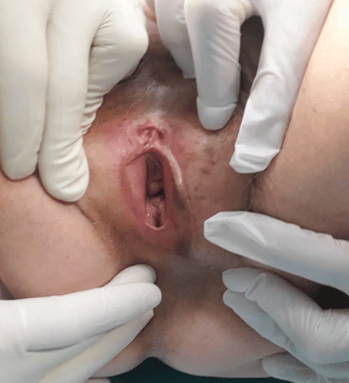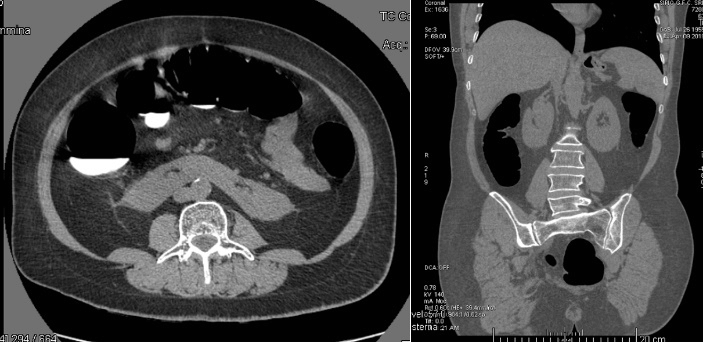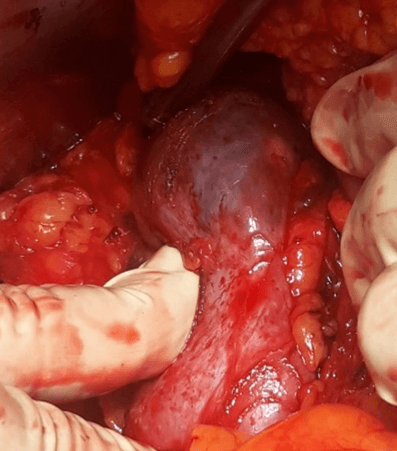A Unique Case of Anal Atresia with Vestibular Anus, Colorectal Cancer and Renal Cancer in Horseshoe Kidney in Adult Woman: A Case Report and Literature Review
A B S T R A C T
Introduction: Colorectal cancer is a very common malignancy, however the association with kidney cancer is very unusual, even more so if kidney cancer occurs on a horseshoe kidney. Horseshoe kidney is a congenital malformation in which the kidneys appear fused. It is often accompanied by abnormalities of the ureteropelvic and vascular systems, so patients in need of surgery should be carefully evaluated.
Materials and Methods: A 64-year-old woman came to our observation with abnormalities of the perineum such as the "vestibular anus", horseshoe kidney, kidney cancer and colorectal cancer. She underwent left open hemicolectomy and right polar resection of the horseshoe kidney.
Results: The patient was discharged on the sixth operating day without complications. At the follow-up 54 months after surgery, she was negative for distant metastasis and local disease recovery.
Conclusion: From a literature review this is the first case report in a patient with these four associated comorbidities. Preoperative evaluation in these patients by CT is important to evaluate the relation between the nervous, vascular and urinary structures to avoid iatrogenic injury.
Keywords
Horseshoe kidney, colorectal cancer, renal cancer, anorectal malformation
Introduction
Colorectal cancer (CRC) is the third most commonly diagnosed cancer among men and women in the United States [1]. However, association with renal cell carcinoma and other unusual alterations such as horseshoe kidney is extremely rare [2-4]. The horseshoe kidney is a common anomaly consisting of a renal fusion, accompanied by anomalies in the course of the ureter, renal vascularization and anomalies of relation with the inferior mesenteric artery. Anorectal malformation is a congenital disease of the anal canal, rectum and colon that occurs from 1.33 to 4.93 out of 10,000 births worldwide. We present a rare case of a female who suffered from horseshoe kidney, genitourinary anomalies with vestibular anus, renal cancer and left colon cancer. There is no evidence in the literature of the association of these four comorbidities. Successfully treated with left open hemicolectomy, right polar resection of the horse kidney.
Case Report
A 64-year-old woman presented at another hospital with abdominal pain, and episodes of rectal bleeding. The patient had no family history of cancer. She was born with a vestibular anus that had been not corrected (Figure 1). She reports that she often suffered from recurrent cystitis and recurrent vaginal infections due to the proximity between the anus and the vagina but never wanted to undergo surgery, the patient underwent virtual colonoscopy which showed in addition to a suspicious mass of the left colon, also a suspicious mass in a fused kidney (Figure 2). Colonoscopy demonstrated, at 20 cm from anal verge, a polypoid colon neoplasm of 3, 5 cm in diameter, whose biopsy were positive for malignancy. CT scan showed anomalous locations of left ureter adherent to the medial sigmoidal mesocolon and upper polar mass in the right kidney, solid nodular neoformation which has an altered enhancement about 4 x 3.5 cm suggesting a renal neoplasm.
Figure 1: Conformation of the patient's perineum with anal atresia and vestibular anus, this condition makes difficult to introduce circular trans-suture staple.
Figure 2: CT axial and sagittal images showing the fused kidney.
Figure 3: Intraoperative image of the right upper pole renal tumor.
Due to the conformation of the patient (Figure 3) that made it impossible to carry out a trans-anal anastomosis with circular trans-suture staple 29 mm, an open left hemicolectomy was performed with trans-colic anastomosis and upper right polar resection of the horseshoe kidney (Figure 4) using a 20 cm median incision. Division of IMA at its origin and anterior colon resection was successfully performed by careful mobilization of the mesocolon to avoid exposing the retroperitoneal organs. The operative time was 162 min, and the blood loss was 40 mL.
Pathological examination demonstrated the presence of adenocarcinoma with no metastasis of the lymph node and chromophobe renal cell carcinoma confined to the kidney. The tumor was type 2, 25 × 30 mm pT 2, pN0, corresponding to pStage IIA. The post-operative period was uneventful, and she was discharged six days after the surgery. The patient remains well without any sign of recurrence and metastasis at 54 months after surgery.
Discussion
The correlation between renal cancer and colorectal cancer is rare [7]. Even more rare is the coexistence of patients with horseshoe kidney and colorectal cancer. A literature search revealed 27 patients who underwent surgery for colon cancer with concomitant horseshoe kidney including our patient, from 1983 to 2020 [4, 8-10]. Only in one case was confirmed the presence of renal carcinoma arising on horseshoe kidney and colorecat cancer [9]. Laparoscopy is widely used to approach colorectal cancer, but the treatment of renal tumors in patients with renal anomalies must be performed in specialized centers and require extensive experience of the surgeon [11-13]. Kidney cancer in a horseshoe kidney is about 50 cases treated with a minimally invasive approach [14-21]. Although there is no previous report describing colonic resection and polar upper resection in horseshoe kidney in patient with double primary tumor, fused kidney and the genitourinary anomaly with anus in the vaginal vestibule. In this patient, anus was divided by a thin membranous septum from the vagina.
Taking into consideration the patient's genital malformation, the inability to use a circular suture device via the anal route, the localization of the tumor (approximately 20 cm from the external anal margin) and a suspected renal mass , the obligation to make a manual anastomosis, laparotomic surgical treatment was chosen. Before the surgery we studied the vascularization of the kidney and the relationship with the left colon with CT. The patient presented an aberrant course of the left ureter that was posterior to the inferior mesenteric artery and with a more medial course than normal. This has made us even more inclined towards open surgery. The presence of the horseshoe kidney is often accompanied by aberrant renal arteries, by an abnormal course of the ureter. CT is useful to determine the position of these structures and avoid intraoperative lesions of such structures as of the organs retroperitoneal, gonadal vessels, aberrant renal veins, the kidney itself and urinary tract. In these cases, injuries to the fused kidney and urinary tract would involve much more complex repair operations. In general, properly dissecting the layer behind the prehypogastric nerve fascia, while recognizing the autonomic nerves as landmarks of the retroperitoneal organs that should be preserved, is the key procedure for safe mesocolon mobilization in both open and laparoscopic surgery [4, 22-24].
Conclusion
We suggest that adequate preoperative planning be implemented to perform procedures that adhere to the principles described above for patients with renal malformations, who must undergo surgical treatment. In the case of anorectal malformations, not previously treated surgically, the risk of performing a transanal anastomosis should always be evaluated, in order to avoid injury to the sphincter as well.
Acknowledgements
Not applicable.
Funding
None.
Author Contributions
DG, LG, MTC and MT conceptualized and designed the study, acquired, and analysed data, interpreted the study results, drafted the manuscript, and critically revised the final version of the manuscript.
Ethics Approval and Consent to Participate
All procedures performed in studies involving human participants were in accordance with the ethical standards of the institutional and/or national research committee and with the 1964 Helsinki Declaration and its later amendments or comparable ethical standards.
Consent for Publication
Written informed consent was obtained from the patient for publication of this case report and any accompanying images.
Competing Interests
None.
Article Info
Article Type
Case Report and Review of the LiteraturePublication history
Received: Fri 13, Nov 2020Accepted: Mon 23, Nov 2020
Published: Fri 04, Dec 2020
Copyright
© 2023 Denise Gambardella. This is an open-access article distributed under the terms of the Creative Commons Attribution License, which permits unrestricted use, distribution, and reproduction in any medium, provided the original author and source are credited. Hosting by Science Repository.DOI: 10.31487/j.GSCR.2020.02.08
Author Info
Denise Gambardella Luigino Borrello Maria Teresa Caruso Francesco Loria Manfredo Tedesco
Corresponding Author
Denise GambardellaDepartment of Medical and Surgical Sciences (Director Giuseppe Sammarco), University of Catanzaro, Catanzaro, Italy
Figures & Tables



References
- Siegel RL, Miller KD, Fedewa SA, Ahnen DJ, Meester RGS et al. (2017) Colorectal cancer statistics, 2017. CA Cancer J Clin 67: 177-193. [Crossref]
- Petejova N, Martinek A (2016) Renal cell carcinoma: Review of etiology, pathophysiology and risk factors. Biomed Pap Med Fac Univ Palacky Olomouc Czech Repub 160: 183-194. [Crossref]
- Halak M, Hazzan D, Kovacs Z, Shiloni E (2000) Synchronous colorectal and renal carcinomas: a noteworthy clinical entity. Report of five cases. Dis Colon Rectum 43: 1314-1315. [Crossref]
- Kubo N, Furusawa N, Imai S, Terada M (2018) A case of laparoscopic high anterior resection of rectosigmoid colon cancer associated with a horseshoe kidney using preoperative 3D-CT angiography. Surg Case Rep 4: 66. [Crossref]
- Midrio P, Battaglia S, Urso E, Castagnetti M, Gamba P (2016) Rectal adenocarcinoma in patients with anorectal malformations: report of two cases and a review of the literature. Springerplus 5: 1623. [Crossref]
- Gupta A, Bischoff A, Peña A, Runck LA, Guasch G (2014) The Great Divide: Understanding Cloacal Septation, Malformation, and Implications for Surgeons. Pediatr Surg Int 30: 1089-1095. [Crossref]
- Petrović M, Andrejević V, Djurasić L, Stamenković V, Acimović M et al. (2012) Tumors of the horseshoe kidney--characteristics and literature review. Acta Chir Iugosl 59: 53-55. [Crossref]
- Tamaoka K, Ohtsuka M, Mikamori M, Saito T, Furukawa K et al. (2020) Single-Incision Laparoscopic Colectomy for Descending Colon Cancer in a Patient with a Horseshoe Kidney. Gan To Kagaku Ryoho 47: 301-303. [Crossref]
- Ho CL, Chen S, Leung YL, Cheng KC, Wong YH (2019) Clin. Dual-Tracer PET/CT Differentiates 2 Types of Primary Cancers and Metastases in a Patient With Crossed Fused Renal Ectopia. Nucl Med 44: 157-158. [Crossref]
- Giani A, Garancini M, Delitala A, Riva L, Gianotti L et al. (2017) 3D-laparoscopic anterior rectal resection in a patient with crossed fused renal ectopia: the importance of 3D imaging. Minerva Chir 72: 546-547. [Crossref]
- Osagiede O, Spaulding AC, Cochuyt JJ, Naessens J, Merchea A et al. (2019) Trends in the Use of Laparoscopy and Robotics for Colorectal Cancer in Florida. J Laparoendosc Adv Surg Tech A 29: 926-933. [Crossref]
- Devoto L, Celentano V, Cohen R, Khan J, Chand M (2017) Colorectal cancer surgery in the very elderly patient: a systematic review of laparoscopic versus open colorectal resection. Int J Colorectal Dis 32: 1237-1242. [Crossref]
- Tanis PJ, Buskens CJ, Bemelman WA (2014) Laparoscopy for colorectal cancer. Best Pract Res Clin Gastroenterol 28: 29-39. [Crossref]
- Kochkin AD, Gallyamov EA, Medvedev VL, Popov SV, Biktimirov RG et al. (2019) Horseshoe kidney tumor laparoscopic surgery. First 19 cases. Urologiia 2 :36-39. [Crossref]
- Tuncel A, Erkan A, Sofikerim M, Arslan M, Kordan Y et al. (2016) Laparoscopic heminephrectomy for benign and malignant diseases of the horseshoe kidney. Arch Ital Urol Androl 88: 255-257. [Crossref]
- Mercader C, Vilaseca A, Moreno JL, López L, Sebastià MC et al. (2019) Role of the three-dimensional printing technology incomplex laparoscopic renal surgery: a renal tumor in a horseshoe kidney. Int Braz J Urol 45: 1129-1135. [Crossref]
- Ohtake S, Kawahara T, Noguchi G, Nakaigawa N, Chiba K et al. (2018) Renal Cell Carcinoma in a Horseshoe Kidney Treated with Laparoscopic Partial Nephrectomy. Case Rep Oncol Med 2018: 7135180. [Crossref]
- Rebouças RB, Monteiro RC, Souza TN, Barbosa PF, Pereira GG et al. (2013) Pure laparoscopic radical heminephrectomy for a large renal-cell carcinoma in a horseshoe kidney. Int Braz J Urol 39: 604-605. [Crossref]
- Murakami T, Makiyama K, Miyoshi Y, Ito Y, Iguchi K et al. (2007) A case of laparoscopic heminephroureterectomy for ureter cancer in a horseshoe kidney. Nihon Hinyokika Gakkai Zasshi 98: 786-789. [Crossref]
- Bhayani SB, Andriole GL (2005) Pure laparoscopic radical heminephrectomy and partial isthmusectomy for renal cell carcinoma in a horseshoe kidney: case report and technical considerations. Urology 66: 880. [Crossref]
- Araki M, Link BA, Galati V, Wong C (2007) Case report: hand-assisted laparoscopic radical heminephrectomy for renal-cell carcinoma in a horseshoe kidney. J Endourol 21: 1485-1487. [Crossref]
- Maeda Y, Shinohara T, Nagatsu A, Futakawa N, Hamada T (2014) Laparoscopic resection aided by preoperative 3-D CT angiography for rectosigmoid colon cancer associated with a horseshoe kidney: A case report. Asian J Endosc Surg 7: 317-319. [Crossref]
- Nakai N, Yamaguchi T, Kinugasa Y, Shiomi A, Tomioka H et al. (2015) Laparoscopic sigmoid colectomy for a patient with sigmoid colon cancer and crossed-fused renal ectopia: a case report. Int Surg 100: 423-427. [Crossref]
- Tamaoka K, Ohtsuka M, Mikamori M, Saito T, Furukawa K et al. (2020) Single-Incision Laparoscopic Colectomy for Descending Colon Cancer in a Patient with a Horseshoe Kidney. Gan To Kagaku Ryoho 47: 301-303. [Crossref]
